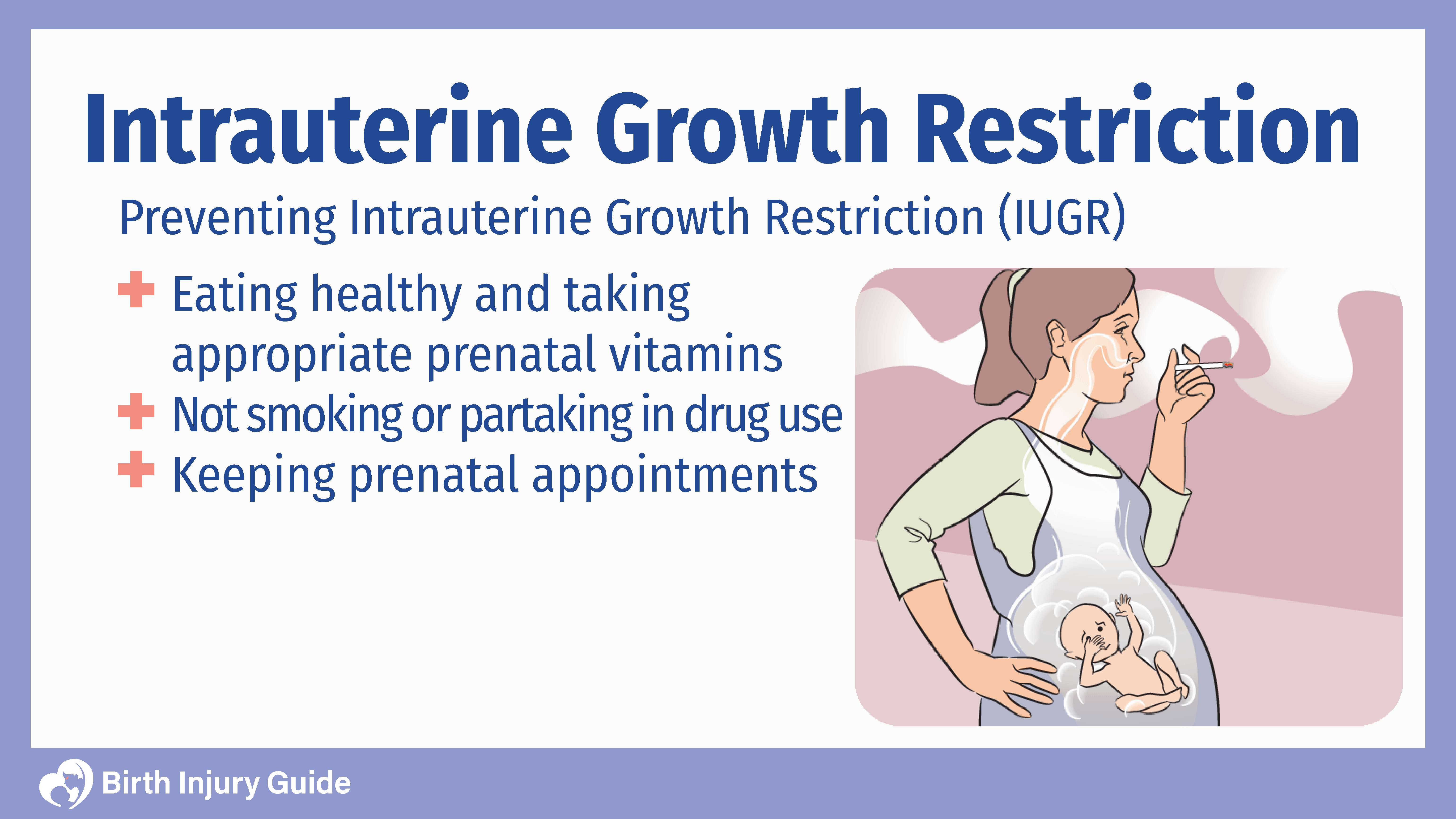
Intrauterine Growth Restriction (IUGR)
Intrauterine growth restriction, formerly retardation, (IUGR) is a medical condition affecting infants who fail to grow as expected during pregnancy. These infants weigh less than the 10th percentile of the normal weight range. The abdominal circumference is typically less than the 2.5 percentile. During the prenatal period, physicians are responsible for monitoring the baby’s growth. If doctors suspect fetal growth restriction, they will check for a sharp difference in the fundal height and weight when compared to other infants with the same gestational age.
What Causes IUGR?
There are an array of reasons why an infant may develop IUGR. Some of the most common include:
- Placenta Issues: If the placenta fails to function properly, the infant may not be able to get adequate oxygen and nutrients.
- Preeclampsia: Preeclampsia increases the risk, especially during the second trimester.
- Chromosomal Disorders: Any chromosomal defect, such as Down’s Syndrome or anencephaly, may lead to low birth weight.
- Maternal Infections: Maternal infections including rubella, toxoplasmosis, and syphilis can increase the risk.
- Malnutrition
- Carrying twins
- Diabetes
- Smoking during pregnancy
- Drug use during pregnancy
Prescription Medications
The prescription medication Depakote has been linked to an increased risk of IUGR. Doctors most often prescribe Depakote to treat conditions such as epilepsy, seizures, manic depressive disorders and bipolar disorder. But when taken while pregnant, infants may be at risk of not only small size and weight, but also:
- Spina Bifida
- Neural Tube Malformation
- Stillborn (fetal death)
- Hydranencephaly
Lexapro, a medication that treats depression, anxiety disorder, and social phobias, may also contribute to IUGR. In fact, a study performed by the National Institutes of Health (NIH) states that a little over 17 percent of infants born to mothers who took Lexapro while pregnant were small for their age. The infants exposed to Lexapro had smaller head sizes, lower birth weights and smaller lengths than the average infant within the same age range.
In some instances, there is no known cause for IUGR. Experts suggest that in these cases, the parents may be smaller than average or live in an area with a higher altitude, leading to unusually small infants.
Risk Factors for Intrauterine Growth Restriction
Infants diagnosed with IUGR may have severe complications during labor and delivery. The complications will greatly depend upon the cause of IUGR and when the baby started experiencing growth issues. One of the most severe consequences is a stillborn birth, which typically occurs when an infant’s weight is below the 5th percentile.
Most infants with IUGR are given repetitive nonstress tests and ultrasounds to assess the weight and amniotic fluid levels. Mothers will undergo a C-section delivery if the baby is unstable. C-sections bring on their own set of risks, including the risk of C-section injuries, breathing problems and low APGAR scores.
Other risk factors include:
- Low blood sugar
- Problems maintaining normal body temperature
- Unusually high red blood count
- Jaundice
- Meconium Aspiration
- Cerebral Palsy
- Learning disabilities
Diagnosis and Treatment of Intrauterine Growth Restriction
In some cases, IUGR can be treated and reversed, if caught early enough. Before treatment starts however, your physician will usually perform several ultrasounds to check for normal organ development, estimated fetal weight and normal movement. In addition, your doctor will also monitor your baby’s heart rate and conduct doppler flow studies to ensure the placental blood flow is adequate. These tests occur beforehand so that your physician can try to pinpoint the reason for growth restriction.
Treatment options will depend upon what caused IUGR in the first place. However, the most common treatment is placing pregnant women on bed rest, which can help the baby’s circulation.
Low doses of aspirin (150 mg or less per day) has also been shown to improve fetal weight and head circumference if taken during the third trimester. However, according to NIH, taking aspirin during the first trimester reduces the risk of IUGR. The study also showed a significant reduction in preeclampsia, a condition that has been linked to growth problems. Yet, some doctors don’t recommend regular aspirin dosage while pregnant. It’s important to discuss the benefits and risks with your own physician, as each pregnancy is different.
In many cases, the only form of treatment may be to induce labor early. This is sometimes necessary in severe cases where the infant is better off outside of the womb. Although there are a host of possible medical issues for preterm infants, it’s normally better to deliver rather than take the risk of additional problems. If infants aren’t receiving adequate nutrients and oxygen while in the womb, there is a chance they could die. The only way to prevent it is early labor induction and delivery.
Can Intrauterine Growth Restriction be Prevented?
Unfortunately, there is currently no guaranteed way of preventing IUGR. However, there are certain things that you can to help reduce the risk, including:

Labor and Delivery Complications
According to the American Academy of Family Physicians (AAFP), at least one-half of all infants born with IUGR will experience asphyxia at birth. Asphyxia should be picked up by fetal heart rate monitoring. Meconium aspiration syndrome and fetal hypoxia are also common. Studies suggest that C-sections are more appropriate for infants with IUGR due to these risk factors and, as mentioned earlier, due to their small size.
Prognosis
The AAFP suggests that most infants with IUGR have a positive prognosis. Many catch up in growth within the first three months. However, studies show that infants may be susceptible to clumsiness, hyperactivity and poor listening skills. In addition, infants are at an increased risk of developing long-term problems such as Type 2 diabetes as adults. Some studies also suggest they are more at risk for abdominal obesity and hypertension.



